#Topkapı Palace
Explore tagged Tumblr posts
Text










Topkapı Sarayı'nda gece müzeciliği dün başladı. Ben de yerinde inceledim. Tarihe gece bakmak, İstanbul'u karanlıklar içinden izlemek güzel bir deneyim. Yine sakince eserleri inceleyebilmek, havanın serinliğinden yararlanıp ferah ferah gezmek doyası bir lezzet veriyor. Ama yerli turistlerimizin bu deneyimi bin TL karşılığında yaşayabilmesi, Müzekart'ın geçmemesini ben doğru bulmuyorum. Bu tür işler piyasacı mantıkla yapılmaz. Kültür, bir eğitimdir. Gecesi ve gündüzüyle. Bu örnekler yaygınlaşmalı ve herkes için ulaşılabilir olmalıdır.
#Topkapı Sarayı#Topkapı Palace#müze#mueseum#gece#night#İstanbul#kültür#culture#tarih#history#art#artist#archaeology#arkeoloji#mimari
47 notes
·
View notes
Text

Topkapı Palace in Istanbul, Turkey
Turkish vintage postcard
#tarjeta#postkaart#sepia#topkapı palace#topkap#carte postale#ansichtskarte#turkish#briefkaart#istanbul#photo#photography#postal#postkarte#palace#vintage#turkey#postcard#historic#ephemera
7 notes
·
View notes
Text

#İstanbul#turkiye#turkey#turkei#bosphorus#sunny day#sunny#sea view#sea#marmarasea#amatuer photography#sky photography#photographers on tumblr#my photos#ozan yağıcı#PartKilla#Lotusyiyen#partkilla Lotusyiyen#Topkapı palace#topkapı sarayı#kadıköy
0 notes
Text


Headband Belonging to Hurrem Sultan, These bands worn across the forehead or tied over the headdress were an important part of women’s costume particularly in the 15th and 16th centuries. This example was found in the tomb of Suleyman’s wife Hurrem Sultan. It was customary to place some of the dead person’s personal possessions over their cenotaph.
Source
#hurrem sultan#ottoman dynasty#ottoman history#ottoman fashion#topkapı sarayı#topkapi palace#topkapi palace museum#long live the queue#magnificent century
28 notes
·
View notes
Text




10 notes
·
View notes
Text

#Past and Present#rc dracula a love story#dracula a love story#mehmed x mc#rc mehmed#rc laia#I laughed when I saw that they used that very room that actually is located in Topkapı palace in Istanbul.#Anachronism
11 notes
·
View notes
Text

Topkapı sarayı
4 notes
·
View notes
Text
An attempt at a Númenorean tughra
Monogram of Elros Tar-Minyatur

An early monogram, displaying few of the features conventionally associated with later devices, or only in germ. The name of the king is in black (Tar-Minyatur) while 'Elenna' is written in red.
---
Monogram of Tar Vardamir, named Nólimon
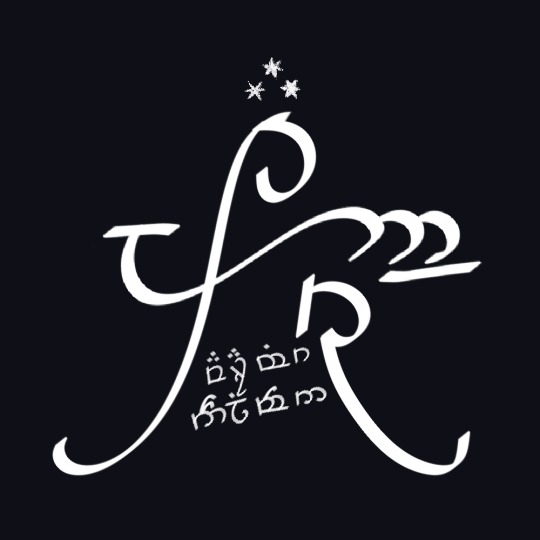
This is certainly an invention of a scribe working long after the death of Vardamir, as the presence of features adopted much later attest - doubtless because the nominal second ruler of Númenor never reigned.
----
Monogram of Tar Amandil

In this monogram, the star shape is more pronounced; the tehta representing the 'a' of 'Elenna' has also been moved to the centre of the device - representing, naturally, the summit of Meneltarma.
---
Monogram of Tar Elendil
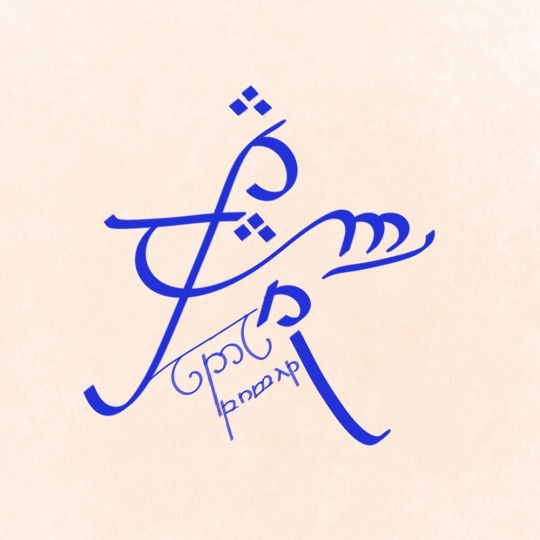
The conventional features are now all present: the star shape is evident, and only the tehtar representing the 'a' in 'Tar' and 'Elenna' have been retained, in symbolic positions, one representing Meneltarma and the other the promontory of Forrostar or, in some interpretations, the stars (clearly the choice made by the scribe who invented the device of Vardamir, perhaps in reverence towards the Valië for whom the king was named).
---
Monogram of Anardil, Tar Aldarion

In this monogram the tehtar are now circumflexes. The king's two names are present, one on land, the other at sea. A ship has been added.
---
Monogram of Tar Ancalimë
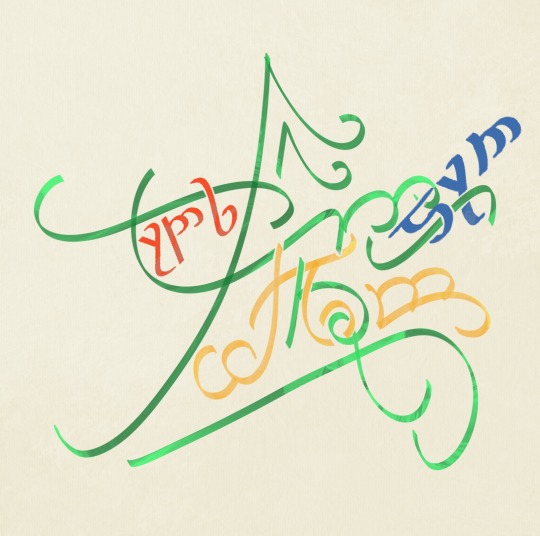
The names of both of the Ruling Queen's parents have been included in this monogram, one that is particularly ornate for the period.
---
explanation: ever since visiting Istanbul a year ago I've been interested in the tughra, a calligraphic monogram used by Ottoman sultans, much as seals were elsewhere (to authentify the sultan's correspondence or official documents), and also on a variety of objects, e.g. here on a wall at Topkapı palace or here on a coin). They started out fairly simple but some ended up being very ornate and gorgeous; and they typically contained the name of the sultan, that of his father, as well as things like epithets and prayers, and also had some conventional features which made them easy to recognise - the beyze (egg), i.e. the loops on the left hand side, and the three tuğ (flagstaff) at the top.
Anyway I've been trying to come up with a Númenorean version and ended up with this, combining some form of the prefix 'Tar' and the name 'Elenna'. As it happens the Ottoman tughra may have had a cartographic element as well - the loops on the left are said to possibly symbolise the two seas - Black Sea, Mediterranean - on whose shores they ruled. Hence the star shape (which I wanted from the start really) and Meneltarma.
I hope I haven't made too many mistakes with the tengwar. I used the classical mode which I've since gathered may not have been the one in use in Númenor or at least not late in Númenor's history... in any case I've taken some wild liberties with the layout anyway, sorry Jirt.
#numenor#tengwar#elros#elros tar minyatur#vardamir#tar amandil#tar elendil#aldarion#tar ancalimë#erendis#worldbuilding
60 notes
·
View notes
Text





SNAKE CHARMER /1879/ by JEAN-LÉON GÉRÔME
This artwork exemplifies Orientalism during its peak in Western European art. Orientalism replicated the aesthetics of Middle Eastern culture. In France, Orientalism gained popularity following Napoleon’s conquest of Egypt and Syria. The French population was truly introduced to Egyptology and became captivated by all things Egyptian.
It is possible that Gérôme spotted a snake charmer while travelling in Egypt. Snake charmers occasionally removed their clothes to prove the authenticity of their act. Gérôme's photo-realistic painting features vibrant colors and intricate detail, yet it is actually a fusion of various cultural stereotypes woven into one image.
The artwork draws inspiration from various origins and blends elements of Ottoman and Egyptian cultures. The complex turquoise wall in the background is inspired by a wall adorned with Iznik tiles from the Topkapı Palace in Istanbul, Turkey. The stone floor takes inspiration from the floor in the Mosque of Amr ibn al-As in Cairo, Egypt.
The figures in the painting are also composite, and they wear garments inspired by various cultural influences from Middle Eastern and Asian nations. Even the snake itself more closely resembles a boa constrictor than a python.
75 notes
·
View notes
Text

Ahmet Ertug
Baghdad Pavilion, Topkapı Palace, 1978
105 notes
·
View notes
Text
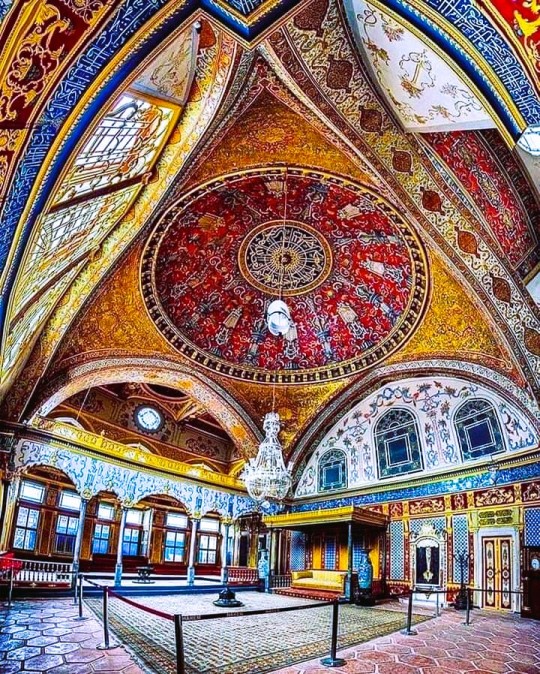
Topkapi Palace, Istanbul, Turkey: The Topkapı Palace, or the Seraglio, is a large museum and library in the east of the Fatih district of Istanbul in Turkey. From the 1460s to the completion of Dolmabahçe Palace in 1856, it served as the administrative center of the Ottoman Empire and was the main residence of its sultans. Wikipedia
105 notes
·
View notes
Note
I wish to give an opinion of daughters of Ibrahim. There is a great abyys in lack of prooves to demarcate daughters of Ibrahim, Atike and Gevherhan. At times, I have an opinion that Atike existed, and at another times that she didn’t exist. For now, I favour the other theory, but i will talk one day about that topic more detailed.
Archiv für Kulturgeschichte Band 77 on page 65, that at the very end of reign of Sultan Ibrahim, Valide Sultan received 125 okka per month, daughters of Murad III named Hümaşah and Hatice received 7 okka per month, daughter of Murad III Fahri(han) received 10 okka per month, Kaya Sultan 16 okka per month, daughters of Ibrahim Gevherhan and Beyhan 30 okka per month and daughter of Ibrahim Fatma 50 okka per month.
Why would Gevherhan and Beyhan receive less stipend than Fatma, as Fatma was adopted and raised by Turhan? Btw, Fatma survived her husband, read Sakaoglu (actually, Ulucay proved it first). Also, in Acta et Diplomata Ragusina, Fatma is mentioned in 1658 document as widow of Fazli Pasha, nothing else is said unfortunately…
Anyway, I would claim that Ayşe Sultan binti Ibrahim really existed. See this quote from work The rise of the Köprülü family (p. 129):
For instance, when Prince Mustafa, the first son of Mehmed IV, was born in Edirne Palace in 1664, Ayşe Sultan, Gevherhan Sultan and Beyhan Sultan, sisters of Mehmed IV, were called to Edirne Palace from Topkapı to join in the celebration for the new prince. This summons shows that some members of the sultan’s family still resided in Topkapı Palace after 1663.
I consider her being the own sister of Mehmed IV. Kütükoğlu was only one right, he was married to Ibrahim’s Ayşe. Ahmed’s Ayşe really died in 1656, in document Vakfiler su defteri there is one document mentioning Ayşe Sultan died before 1660 (if I recall). Her last husband was Ibsir Mustafa Pasha. Sadly, Ibrahim’s Ayşe was wrongly confused also as Ibsir’s wife. Her one and only marriage was with Suleiman Pasha Malatuk (Ermeni). Alderson confused her with Murad IV’s daughter.
In work Atik şikâyet defteri (7 numaralı H.1081-1083/ M.1671-1672) transkripsiyon, Mehmed IV wrote several letters in 1671/72 to his sisters Ayşe and Gevherhan, and their husbands. He doesn’t refer them as hemşirem, but it’s them.
Anyway, in work OSMANLI DEVLETİ’NİN 1660-1661 (HİCRİ 1070-1071) TARİHLİ SEFER BÜTÇESİ (pp. 23-24), there were provided annual payments of some Ottoman princesses in 1661. This payment list does not refer to all of the Sultanas who were knowly alive in 1661, as Ahmed’s daughter Fatma Sultan for example. Only some of them.:
Hâshâ-i hazret-i Valide Sultan 12.000.000
Hâshâ-i paşmaklık-ı Ayşe Sultan 2.595.333
Hâshâ-i paşmaklık-ı Fatıma Sultan 2.005.000
Hâshâ-i paşmaklık-ı Rukiyye Sultan 1.235.000
Hâshâ-i paşmaklık-ı Safiye Sultan 1.005.000
Hâshâ-i paşmaklık-ı Beyhan Sultan 1.560.000 24
Hâshâ-i paşmaklık-ı Gevherhan Sultan 1.520.000
Hâshâ-i Ayşe sultan haseki-i merhum Gazi Sultan Murad Han aleyhi’r-rahmeti ve’l-gufran 100.000
Hâshâ-i paşmaklık-ı Ümmi Sultan 295.000
Hâshâ-i paşmaklık-ı Sâime Sultan 285.000
Hâshâ-i temlik-i merhum Kaya Sultan 1.250.000
See how Mehmed’s cousins (Murad IV’s daughters) and sisters (especially) received high payments, in difference to his aunt Ümmi Sultan and his great-great-aunt Saime Sultan. But, you would notice his sisters Ayşe and Fatma received the highest salaries; Ayşe the very highest as own sister, Fatma little lesser as adopted sister.
Sorry for the long wait, I have been incredibly busy these past few months.
About Ayşe binti Ibrahim, I would refer to this post, in which @rhaenahanzades found that the one married to Ermeni/Malatyalı Süleyman Pasha was Ayşe binti Ahmed I. I’ll paste the citation again, here:
“Soliman passa, Visir della Porta. Ritrouai anche alla Corte per Visir della Porta il Sr Soliman passa, stato un tempo Visir Supremo, dal quale fui all'udienza e lo presentai secondo le comissioni, il quale nell'honorarmi e trattarmi bene non uolse mostrarsi meno cortese degl'altri, offerendosi con molta humanità per ogni occorenza de publici seruitii. Questo Sr è assai noto all'EE. VV. per rellationi di diuersi loro ambassadori, onde a me non occorre tediarle in detto proposito. Dirò solo questo, che non le uol male e che sia personaggio da potterle fauorire, essendo ben uoluto da S. Mtà, col quale è ancor congiunto col uincolo di parentella, mentre la sua zia Aisce sultana tiene per moglie.” (“Dubrovačka akta i povelje” vol. 3, pages 661 and 662)
I believe Ayşe binti Ibrahim died pretty young and therefore never entered the Ragusian ambassadors’ lists of gifts.
As for Fatma binti Ibrahim, I must have missed when it was decided that she had been adopted by Turhan because I have never heard of this.
About the list of payments you’ve found, I’m not sure those princesses are identified correctly:

I have identified them based on seniority and the amount of money, which seems to me to be what their lands yield. I don’t think these are stipends.
Anyway, if we put the princesses in order of amount of money, I think it’d be easier to understand who is who:
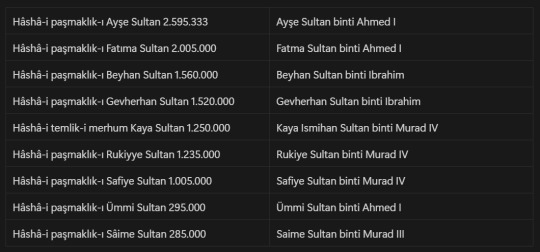
Ayşe and Fatma stand at the top of the hierarchy because a) they’re older and b) they must have amassed a great amount of land during their lives. After them we have the sisters of the reigning sultan (Mehmed IV), so Beyhan and Gevherhan (possibly in order of birth??); then we have Murad IV’s daughters (Kaya is mentioned as deceased because she was at the time), and lastly we have two minor princesses: Saime, a daughter of Murad III and a non-haseki concubine, and Ümmi, either a daughter of Ahmed I or of Murad III as well. I say this because I think their small amount of land means they were not daughters of Haseki Sultans: if Ümmi is Ayşe and Fatma’s sister that’s the only reason she would possess less land than them.
#ask post#ask: ottoman history#kehribar-sultan#ayse sultan daughter of ahmed i#fatma sultan daughter of ahmed i#rukiye sultan daughter of murad iv#safiye sultan daughter of murad iv#kaya ismihan sultan daughter of murad iv#beyhan sultan daughter of ibrahim i#gevherhan sultan daughter of ibrahim i#saime sultan daughter of murad iii#ummi sultan daughter of mehmed iv
12 notes
·
View notes
Text

Baghdad Kiosk in the court of Topkapı Palace, Constantinople, modern-day Istanbul, Turkey
Ottoman vintage postcard
#postal#topkap#palace#turkey#historic#kiosk#ansichtskarte#baghdad#sepia#istanbul#ottoman#vintage#tarjeta#baghdad kiosk#briefkaart#photo#court#topkapı palace#constantinople#modern#postkaart#ephemera#postcard#postkarte#photography#carte postale
1 note
·
View note
Text

#istanbul#turkey#turkish#turkiye#Eminönü#old town#sea#topkapı sarayı#topkapi palace#chillout#chill vibes#chill#rainy#rainyday#rain#winter#winter time#istanbul Winter#my photos#photography#amateur photography#today on tumblr
6 notes
·
View notes
Text

Topkapı Palace 🇹🇷
170 notes
·
View notes
Text

Ottoman kaftan, Italian silk, c. second half of the 16th century CE
On display at Topkapı Palace (İstanbul, Türkiye)
14 notes
·
View notes